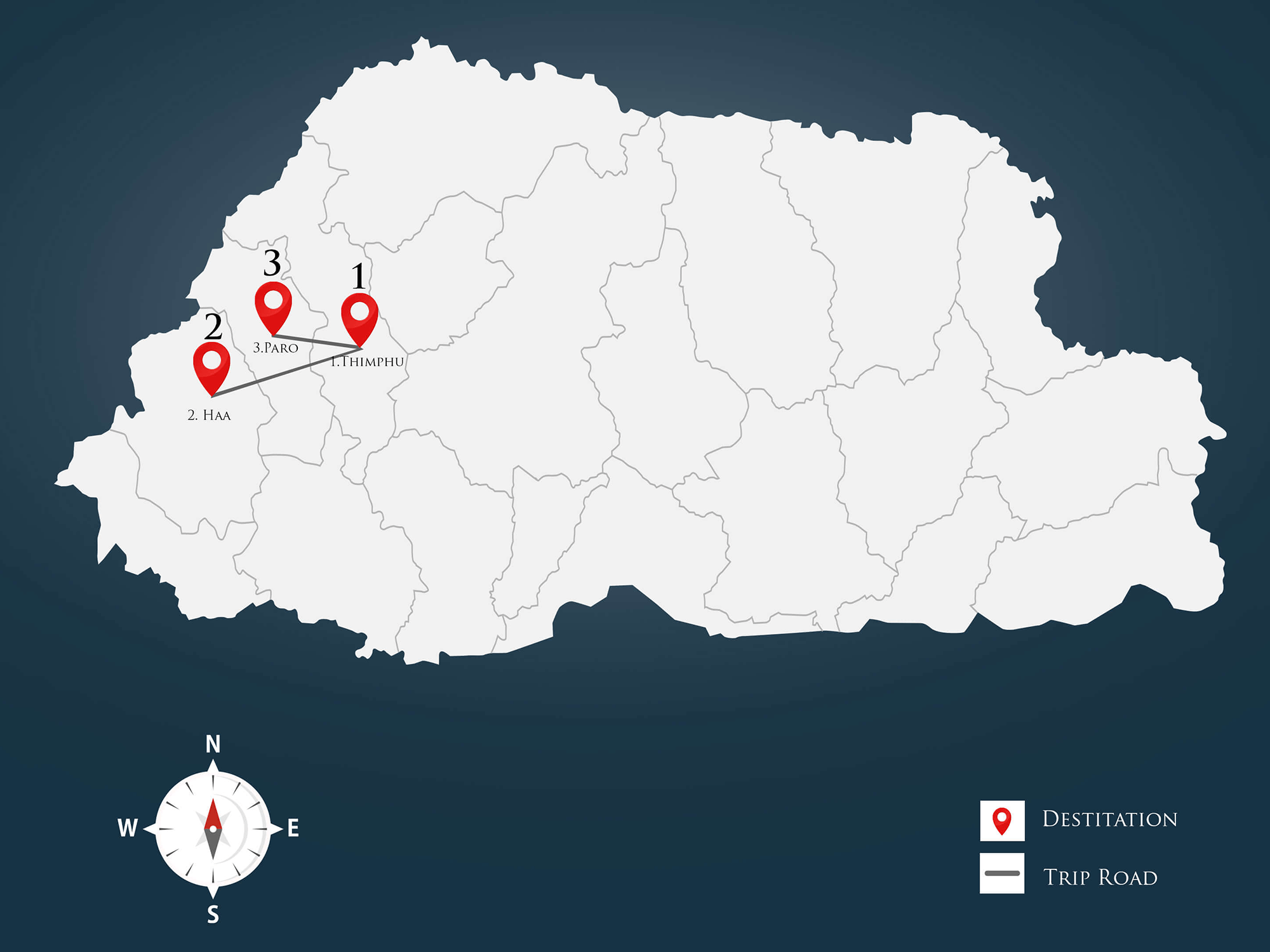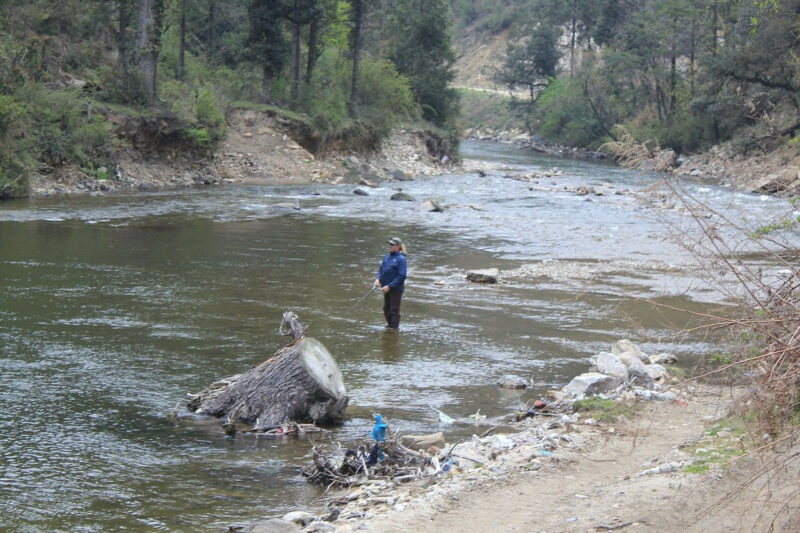Bhutan’s fish and fishing opportunities remain significantly under-discovered. There has yet to be a comprehensive survey of the fish inhabiting the country’s lakes and rivers. About Forty-two species have been recorded, though potentially there may be an additional two hundred or more. Furthermore, since most are not aware of this option, fewer than ten fly-fishers annually visit Bhutan. There therefore exists the chance of making some interesting and unexpected discoveries.
Fishing spots range from large rivers such as at Punakha, the glacial-fed waters of Bumthang, Paro and Thimphu, to the crystal-clear spring-fed streams at Gangtey and Nikachu. Altitudes range from a low of 4,000 to a high of 9,500 feet. The most common varieties are the snow trout (belonging to the carp family) and the brown trout (which has thrived since its introduction some decades ago). The best times for fishing are from March to October. Perhaps what is most remarkable about the fishing experience in Bhutan is the general ambiance. The overall natural environment is one of the purest and richest in the world, and a traditional way of life remains little disturbed by modern influences. Being in Bhutan therefore offers an unusual serenity and a rare sense of being completely detached from one’s everyday life.
Altitude in Paro: 2,280m
Onboard the aircraft, the flight is treated to spectacular views of snow peaked mountains and the Himalayan ranges. Paro airport (2,280m) is Bhutan’s only international airport where our dedicated team will receive you at the airport.
Afternoon by the upper stretches of the Paro Chhu(river).
Altitude in Haa: 2,740m
Distance: 70km
Estimated travel time: 2,5hrs
Haa grants us a fantastic spot for catch and release fishing; trout and sometimes snow trout and catfish are spotted quite regularly in Haa river.
Chelela Pass- One of the highest road passes in Bhutan located between Paro valley and Haa valley. On a clear day, breathtaking views of the Himalayan peaks including Mt. Jomolhair, Mt. Jichu Drake and Mt. Kangchenjunga can been seen. In this region blue poppies (Bhutan’s national flower) also bloom during the period of late May to July.
Kila Goemba Hike- The hike will last around 4-5 hours which begins with a 3km stretch of 500m ascent to the highest point at 4,500m. Passing the highest point, descend and pass through the picturesque hills of rhododendron and hemlock forest reaching the quaint nunnery Kila Goemba which offers the visitor an insight of the life of simplicity and the awe-inspiring view of Paro valley.
Return to Paro
Altitude in Thimphu: 2,320m
Distance: 55km
Estimated travel time: 1.30 hour
Morning fish the Thimphu Chu, afternoon sightseeing and exploring Thimphu.
National Memorial Chorten – one of Bhutan’s most prominent buildings. The Chorten is the monument of world peace and prosperity. For Bhutanese, the site also serves as the memorial to their Third King, His Majesty Jigme Dorji Wangchuck (1928-72).
National Textile MuseumThe heritage museum replicates a rural house in the mid-19th century, using rammed mud timber, presenting objects like the leopard-skin bags and Brokpa yak-hair ‘spider’ hats. The art of Thagzo (weaving) with different styles and on a variety of materials will also be presented.
National Institute for Zorig Chusum (The Arts and Crafts School or Painting school)- The students here are enrolled in a different course that teaches the 13 traditional arts of Bhutan.
Buddha Point (Buddha Dordenma) - At a height of 51,5m, placed on top of a hill in Kuenselphodrang Nature Park, the sight of the enormous statue of Shakyamuni Buddha is stunning and unforgettable. This giant statue is one of the largest in the world and is said to emanate an aura of peace and happiness.
Altitude in Gangtey: 2,900m
Distance: 160km
Estimated travel time: 6hrs
Dochula Pass (3,050m)- Panoramic view of the Himalayan mountains. The pass is a popular location among tourists as it offers a stunning 360 degree panoramic view of the Himalayan mountain range. The view is especially scenic on clear, winter days with snowcapped mountains forming a majestic backdrop to the tranquility of the 108 chortens gracing the mountain pass.
Gangtey Goemba or ‘Gangtey monastery’- The only Nyingmapa monastery in this region, sitting on the crest of a hill on top of Gangtey valley. The monastery was built in 1613 following the prophecy of Pema Lingpa – the famous 15th-century treasure finder.
Cycling or hiking in the valley as well as watching the cranes during the winter months.
Black-necked Crane Visitor Centre- The center focuses on sustainable ecotourism activities, environmental education, and conservation programs in Phobjikha valley. The building’s location allows people to overlook the wetlands, which is the Black-necked crane’s habitat.
Cycling or hiking in the valley as well as watching the cranes during the winter months. Stop for tea or lunch in a traditional farmhouse.
Altitude in Bumthang: 2,800m
Distance: 158km
Estimated travel time: 6hrs
Pele La Pass, Chendebji Chorten, Trongsa and fish at the Nikka Chhu.
Fishing by the Chamkhar Chhu - Stay in Camp or Local Guest House or hotel.
Next day fishing continues along theTang Chhu - Stay Camp or Local Guest House or hotel.
Altitude in Punakha: 1300m
Distance: 212km
Estimated time: 8hrs
To Punakha via Wangdiphodrang. Fish in the Punakha river.
Altitude in Paro: 2,280m
Distance: 125km
Estimated travel time: 4hrs
Return to Paro and continue with more fishing along the river and hot spots.
sTaktsang Monastery, or the Tiger’s Nest (highest altitude: 3,120m)- A 4.5 km hike that will typically take 5-6 hours ascending around 600m to reach the destination. An experience through dense enchanted forests and spectacular mountain scenery along the trail.
Kyichu Lhakhang- one of the 108 temples built throughout the Himalayas by the Tibetan King Songtsen Gampo in the 7th century. The main chapel has roots as far back as the 7th century, with additional buildings and a golden roof added in 1839 by the penlop (governor) of Paro and the 25th Je Khenpo. Elderly pilgrims constantly shuffle around the temple spinning its many prayer wheels, making this one of the most charming spots in the Paro valley.
A traditional hot stone bath at the farmhouse after all the hiking is also an option provided for relaxation.
A stroll through Paro town.


